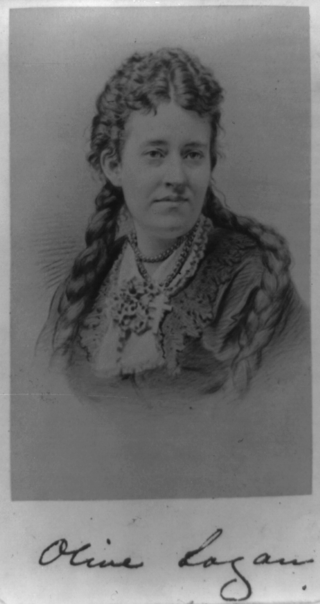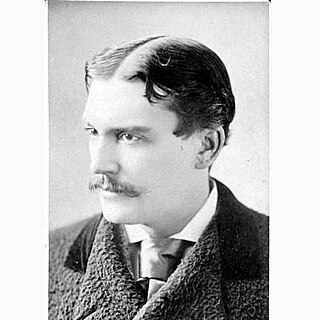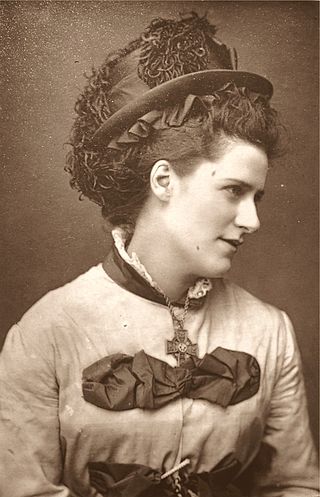
William Wilkie Collins was an English novelist and playwright known especially for The Woman in White (1859), a mystery novel and early sensation novel, and for The Moonstone (1868), which established many of the ground rules of the modern detective novel and is also perhaps the earliest clear example of the police procedural genre.
The sensation novel, also sensation fiction, was a literary genre of fiction that achieved peak popularity in Great Britain in the 1860s and 1870s, centering taboo material shocking to its readers as a means of musing on contemporary social anxieties.

Ada Rehan was an American actress and comedian who typified the "personality" style of acting in the nineteenth century.

Olive Logan was an American actress and author, daughter of Irish-American actor and playwright Cornelius Ambrosius Logan and Eliza Akeley.

Henry James Montague was the stage name of Henry John Mann,, an American actor born in England.

Henrietta Hodson was an English actress and theatre manager best known for her portrayal of comedy roles in the Victorian era. She had a long affair with the journalist-turned-politician Henry Labouchère, later marrying him.

Stella Boniface Weaver was a stage actress from Richmond, Virginia. In the late 1870s and 1880s she was an important member of the company of Lester Wallack, at 13th Street and Broadway (Manhattan). She appeared in Wallack productions of False Shame (1877), The School For Scandal (1878), Our Club (1878), and My Son (1878).

Henrietta Mary Ada Ward was a British historical and genre painter of the Victorian era and the early twentieth century.

Ada Cavendish was an English actress known for her Shakespearean roles and for popularising the plays of Wilkie Collins in America.

Caroline Lucreza Brook Hill was an English actress. She began acting as a child in the company of Samuel Phelps and soon joined the company of J. B. Buckstone at the Haymarket Theatre. There she created roles in several new plays, including some by W. S. Gilbert, in whose plays she continued to act later in her career. She played at various London and provincial theatres in the 1870s. Hill married actor Herbert Kelcey in 1883, with whom she had begun to appear on stage. The couple played mostly in New York City in the 1880s, and, mostly in England, Hill continued to act through the 1890s.

Helena Cécile Ernstone,(néeHélène Cecilia Schott; circa 1841 Gibraltar – 2 July 1933 Ferndown, Dorset, England) was an English actress who appeared in London theatres from 1867 to 1881.

Sarah Jane Woolgar was an English stage actress. She had leading roles in plays by notable dramatists of the day, including original productions. She had a long association with the Adelphi Theatre in London.

Mary Jeffreys Lewis known professionally as Jeffreys Lewis was a British-born American actress whose career lasted long after her popularity as a leading lady had faded.

Rose Leclercq was an English actress, possibly best known for creating the role of Lady Bracknell in Oscar Wilde's The Importance of Being Earnest in 1895.

Sarah Frances Marie Martinot was an American actress and soprano singer who performed on stage in dramas, musical comedy and comic opera. Her career began at the age fifteen as Cupid in Ixion; or, the Man at the Wheel and, but for a few years absence, she remained active on stage in America and abroad until 1908. She was the first to play Hebe in an American production of H.M.S. Pinafore, the first Katrina in the comic opera Rip Van Winkle and the first to play the title role in an English adaptation of the operetta Nanon. Late in her life Martinot would fall victim to mental illness and spend her last few years confined to psychiatric institutions.

Jennie Lee was a Victorian Era English stage actress, singer and dancer whose career was largely entwined with the title role in Jo, a melodrama her husband, John Pringle Burnett, wove around a relatively minor character from the Charles Dickens novel, Bleak House. She made her stage debut in London at an early age and found success in New York and San Francisco not long afterwards. Lee may have first starred in Jo around 1874 during her tenure at San Francisco's California Theatre, but her real success came with the play's London debut on 22 February 1876 at the Globe Theatre in Newcastle Street. Jo ran for many months at the Globe and other London venues before embarking for several seasons on tours of the British Isles, a return to North America, tours of Australia and New Zealand and later revivals in Britain. Reduced circumstances over her final years forced Lee to seek assistance from an actor's pension fund subsidised in part by proceeds from Royal Command Performances.

Isabella Hill, better known as Mrs Howard Paul, was an English actress, operatic singer and actress-manager of the Victorian era, best remembered for creating the role of Lady Sangazure in the Gilbert and Sullivan comic opera The Sorcerer (1877).

Elizabeth Ponisi Wallis, née Hansom or Hanson, known throughout her career as Madame Ponisi, was an English-American actress.

Mary Charlotte Moore, Lady Wyndham, was an English actress and theatrical manager. She was known for her appearances in comedies alongside the actor-manager Charles Wyndham between 1885 and his retirement in 1913. Over these three decades they acted mainly in contemporary plays, many written for them by authors including Henry Arthur Jones and Hubert Henry Davies, but also appeared in classic comedies together. She continued to act on stage until 1919. She was married to the playwright James Albery from 1879 to 1889, and after his death her relationship with Wyndham eventually became romantic. After the death of Wyndham's estranged wife in 1916, he and Moore married.

Miriam O'Leary Collins was an American stage actor associated with Boston Museum theatre. After marriage, she staged plays, several times for the benefit of the Home for Destitute Catholic Children. She also worked as a elocution and dramatic action coach.


















